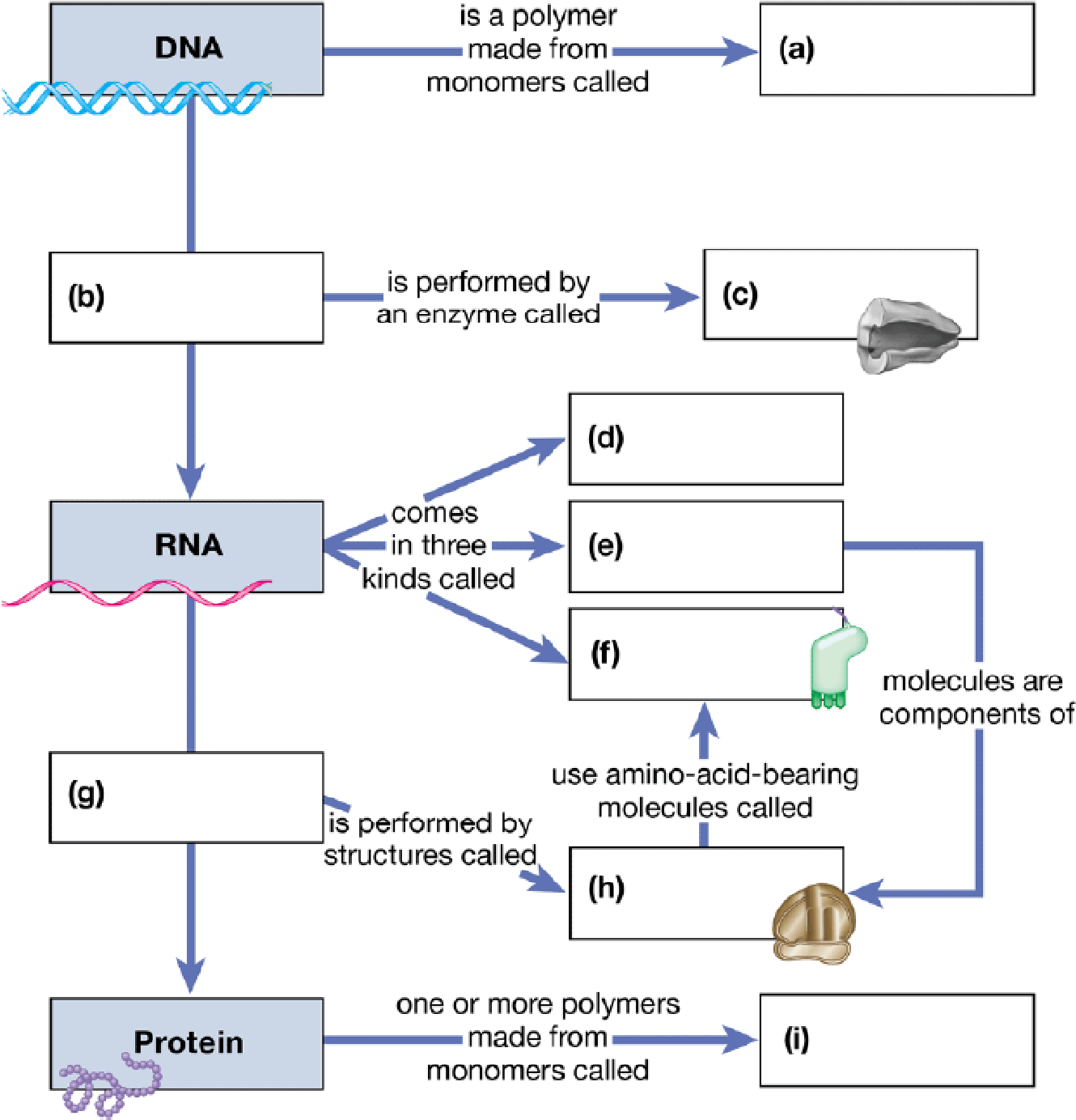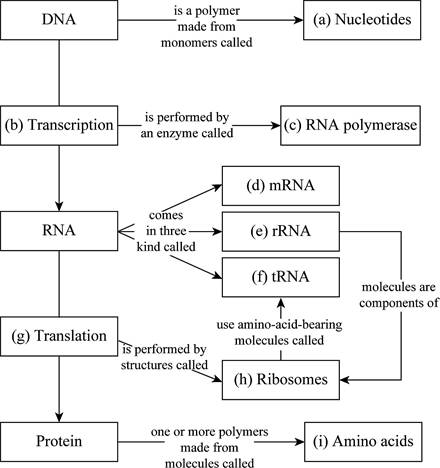
Concept explainers
Check your understanding of the flow of genetic information through a cell by filling in the blanks.

To complete: The given map showing the flow of genetic information through a cell.
Introduction: DNA is the blueprint of life. The genetic information of DNA is based in the nucleotide base sequences. These sequences are transcribed into mRNA triplets. These triplets of nucleotides are known as codons and they form the genetic code. They code for specific amino acids for the synthesis of proteins is known as functional gene products. This is known as gene expression.
Answer to Problem 1CC
Pictorial representation: Fig. 1 shows the completed map of flow of genetic information through a cell.

Fig.1 Flow of genetic information through a cell
Explanation of Solution
(a)
Correct answer: Nucleotides.
Explanation: The nucleotides are the building blocks of nucleic acids (DNA and RNA). DNA is a polymer made up of nucleotide monomers (adenine, thymine, cytosine, and guanine) and also known as polynucleotide. Hence, the correct answer is nucleotides.
(b)
Correct answer: Transcription.
Explanation: DNA consists of genetic instructions in the form of nucleotide sequences. It acts as a template and directs the messenger RNA (mRNA) synthesis in the cell. The process of formation of mRNA is known as transcription. Hence, the correct answer is transcription.
(c)
Correct answer: RNA polymerase.
Explanation: RNA polymerase enzymes are of three types out of which, RNA pol II transcribes mRNA. RNA pol II enzyme first binds to the transcription factors and then forms a complex with promoter at start codon for the beginning of transcription process. Hence, the correct answer is RNA polymerase.
(d)
Correct answer: mRNA.
Explanation: Both prokaryotes and eukaryotes consist of three types of RNA: mRNA, rRNA, and tRNA. mRNA forms 5% of the total RNA in a cell. mRNA consists of the genetic code in the form of triplets of nucleotides known as codons. Hence, the correct answer is mRNA.
(e)
Correct answer: rRNA
Explanation: rRNA forms 80% of the total RNA and is found in ribosomes. rRNAs along with proteins form ribosomes, which act as a site for protein synthesis. Hence, the correct answer is rRNA.
(f)
Correct answer: tRNA
Explanation: tRNAs are smallest among the three types of RNA. The mRNA sequence is read by transfer RNAs (tRNAs) to form polypeptide or a chain of amino acids in a process known as translation. The tRNA molecule with an attached amino acid binds to its specific mRNA codon. This mRNA codon codes for that specific amino acid. Hence, the correct answer is tRNA.
(g)
Correct answer: Translation.
Explanation: The mRNA acts as a template for the synthesis of polypeptide chain. Each letter in the gene sequence is copied which codes for a particular amino acid. The polypeptide chain is synthesized on the basis of amino acid sequences in the reading frame. This process is known as translation. Hence, the correct answer is translation.
(h)
Correct answer: Ribosomes.
Explanation: rRNAs along with proteins form ribosomes. Ribosomes act as a site of protein synthesis, that is, translation. Hence, the correct answer is ribosomes.
(i)
Correct answer: Amino acids.
Explanation: Amino acids are the monomer units of proteins. Amino acids are linked through peptide bonds to form a long polypeptide chain. Hence, the correct answer is amino acids.
Want to see more full solutions like this?
Chapter 10 Solutions
Campbell Biology: Concepts & Connections, Books a la Carte Plus Mastering Biology with eText -- Access Card Package (8th Edition)
- examples of synamtomorphy.arrow_forwardE. Bar Graph Use the same technique to upload the completed image. We will use a different type of graph to derive additional information from the CO2 data (Fig A1.6.2) 1. Calculate the average rate of increase in COz concentration per year for the time intervals 1959-1969, 1969- 1979, etc. and write the results in the spaces provided. The value for 1959-1969 is provided for you as an example. 2. Plot the results as a bar graph. The 1959-1969 is plotted for you. 3. Choose the graph that looks the most like yours A) E BAR GRAPH We will use a different type of graph to derive additional information from the CU, data (rig. nive). Average Yearly Rate of Observatory, Hawall interval Rate of increase per year 1959-1969 0.9 1969-1979 1979-1989 1989-1999 1999-2009 Figure A1.6.2 1999-2009 *- mrame -11- -n4 P2 جية 1989-1999 1979-1989 1969-1979 1959-1969 This bar drawn for you as an example 1.0 CO, Average Increase/Year (ppmv) B) E BAR GRAPH We will use a different type of graph to derive…arrow_forwardUse the relationships you just described to compute the values needed to fill in the blanks in the table in Fig A1.4.1 depth (a) 1.0 cml 0.7 cml cm| base dimensions (b, c)| 1.0 cm| 1.0 cm| 1.0 cm 1.0 cm| 1.0 cm| 1.0 cm volume (V) 1.0_cm' cm'| cm'| density (p) 1.0 g/cm'| 1.0 g/cm 1.0 g/cm' mass (m)| 0.3 g Column 1: depth at 1.0 cm volume mass Column 2: depth at 0.7 cm volume mass Column 3: unknown depth depth volumearrow_forward
- San Andreas Transform Boundary Plate Motion The geologic map below of southern California shows the position of the famous San Andreas Fault, a transform plate boundary between the North American Plate (east side) and the Pacific Plate (west side). The relative motion between the plates is indicated by the half arrows along the transform plate boundary (i.e., the Pacific Plate is moving to the northwest relative to the North American Plate). Note the two bodies of Oligocene volcanic rocks (labeled Ov) on the map in the previous page located along either side of the San Andreas Fault. These rocks are about 23.5 million years old and were once one body of rock. They have been separated by displacement along the fault. 21. Based on the offset of these volcanic rocks, what is the average annual rate of relative plate motion in cm/yr? SAF lab 2.jpg Group of answer choices 0.67 cm/yr 2 cm/yr 6.7 cm/yr 1.5 cm/yr CALIFORNIA Berkeley San Francisco K Os Q San Andreas Fault Ov…arrow_forwardThese are NOT part of any graded assignment. Are there other examples of synapomorphy. What is it called when the traits retained are similar to ancestors?arrow_forwardPlease hand draw everying. Thank you! Draw a gram positive bacterial cell below. Your cell should have the following parts, labeled: A coccus shape A capsule The gram positive cell wall should have the peptidoglycan labeled, as well as its component parts (NAM, NAG, and teichoic acid) A cell membrane Fimbriae A nucleoid Ribosomes Inclusionsarrow_forward
- Draw a gram negative bacterial cell below. Your cell should have the following parts, labeled: A bacillus shape Fimbriae Amphitrichous flagella 2 membranes (outer and inner) The outer membrane should have lipopolysaccharide (LPS) with lipid A and O antigens Periplasmic space The thin peptidoglycan cell wall between the 2 membranes A nucleoid Ribosomes Inclusionsarrow_forwardBacterial species Cell wall type Example: S. mitis Gram positive S. epidermidis H. pylori M. bovis S. marcescens Shape and arrangement Coccus, streptococcus Drawing 0000000arrow_forwardDraw a gram positive bacterial cell below. Your cell should have the following parts, labeled: A coccus shape A capsule The gram positive cell wall should have the peptidoglycan labeled, as well as its component parts (NAM, NAG, and teichoic acid) A cell membrane Fimbriae A nucleoid Ribosomes Inclusionsarrow_forward
 Biology (MindTap Course List)BiologyISBN:9781337392938Author:Eldra Solomon, Charles Martin, Diana W. Martin, Linda R. BergPublisher:Cengage Learning
Biology (MindTap Course List)BiologyISBN:9781337392938Author:Eldra Solomon, Charles Martin, Diana W. Martin, Linda R. BergPublisher:Cengage Learning
 Human Biology (MindTap Course List)BiologyISBN:9781305112100Author:Cecie Starr, Beverly McMillanPublisher:Cengage Learning
Human Biology (MindTap Course List)BiologyISBN:9781305112100Author:Cecie Starr, Beverly McMillanPublisher:Cengage Learning Biology Today and Tomorrow without Physiology (Mi...BiologyISBN:9781305117396Author:Cecie Starr, Christine Evers, Lisa StarrPublisher:Cengage Learning
Biology Today and Tomorrow without Physiology (Mi...BiologyISBN:9781305117396Author:Cecie Starr, Christine Evers, Lisa StarrPublisher:Cengage Learning Human Heredity: Principles and Issues (MindTap Co...BiologyISBN:9781305251052Author:Michael CummingsPublisher:Cengage Learning
Human Heredity: Principles and Issues (MindTap Co...BiologyISBN:9781305251052Author:Michael CummingsPublisher:Cengage Learning





